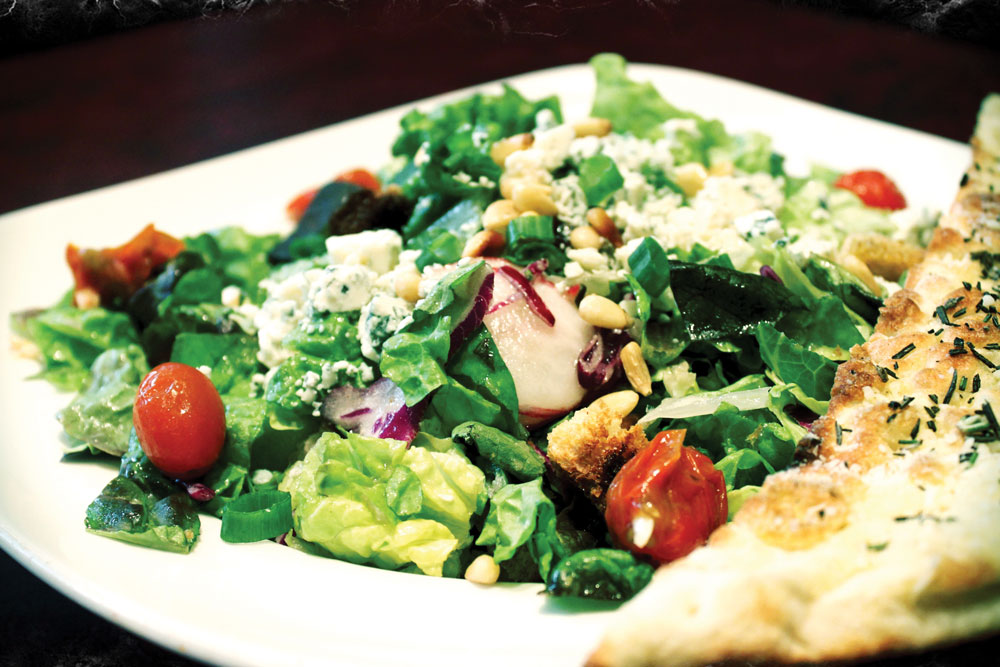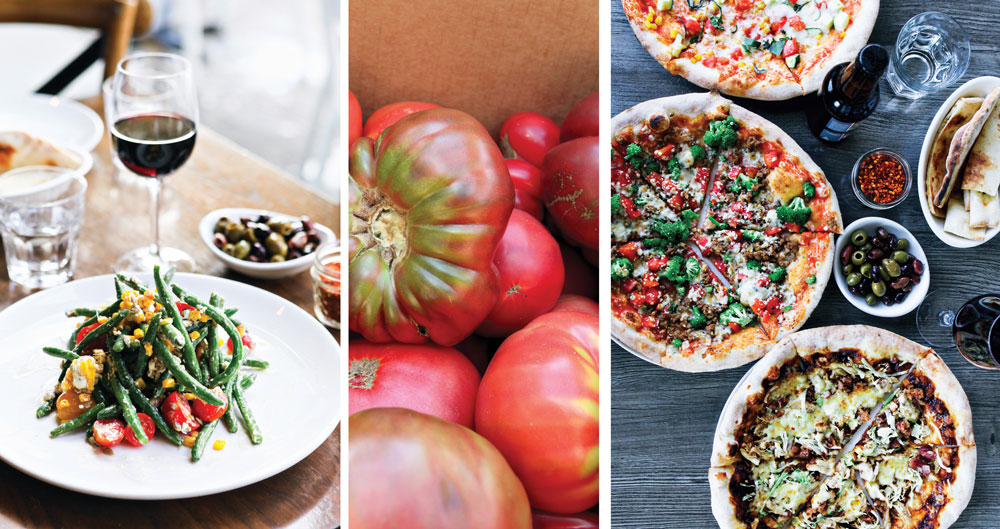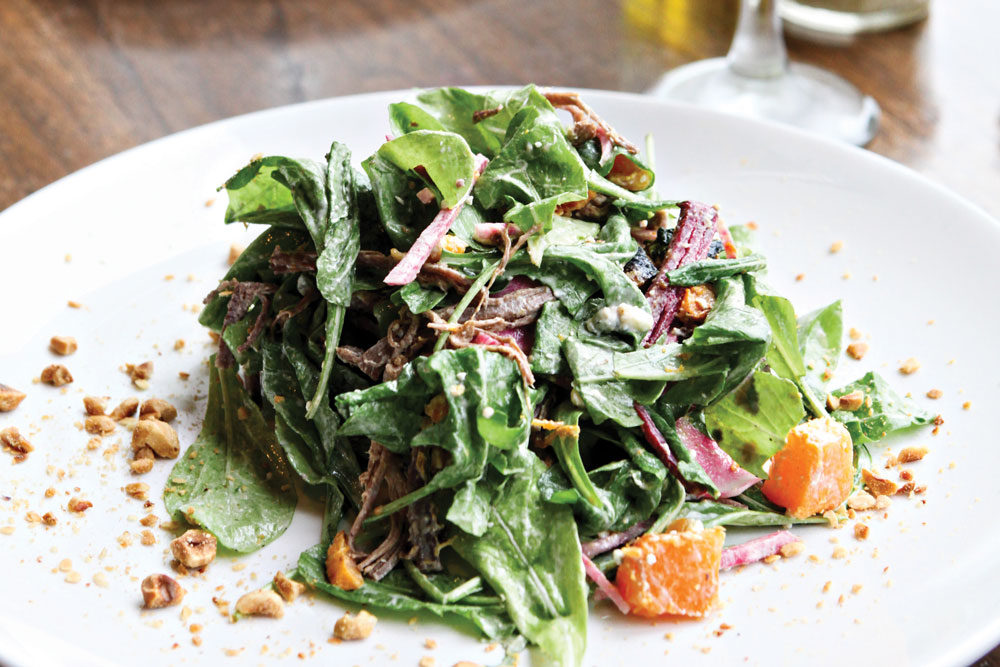Salads may seem like a humble part of your menu, but consider how many classics have become downright famous: the Wedge, the Caesar, the Waldorf, the Cobb. Are your salads as innovative as these standout examples from history once were, or have you gotten stuck in the rut of tossing together less-than-inspiring lettuces with a few tomatoes?
If you want to up the ante with new combinations that offer unexpected touches, take inspiration from pizzerias across the country that are experiencing incredibly successful “salad days.”
 |
|
SPIN! Neapolitan Pizza |
Touching Base
Is there such a thing as a salad without lettuce? More and more salad lovers say yes. Bases such as kale, quinoa and Swiss chard offer something unexpected while boosting both nutrition and flavor, so feel free to get creative by stepping outside of the lettuce box. “Rarely do I use lettuces for a base,” says Tyler Herald, a division chef for U.S. Foods and formerly chef at Napolese in Indianapolis. “I really enjoy roasted vegetables as a base, especially since they showcase the work of the pizza oven. We always have a salad on the menu with beets as the base, and another one of our all-time most popular salads has roasted Brussels sprouts as the base. I’m also really into grains as the base for a salad—there are so many health benefits!”
Related: Grimaldi’s celebrates milestone year with hot dog pizza
When a lettuce-like bed is required, however, Herald admits a love for the peppery bite of arugula. “It’s delicious with just a splash of quality olive oil, a squeeze of lemon, and sea salt and fresh cracked pepper,” he says. “I also really like how well kale can withstand big, bold flavors and hold up to richer dressings.”
Similarly, salad bases receive an artisanal interpretation at Katie’s Pizza & Pasta Osteria in St. Louis. “Instead of iceberg or romaine, we use a spring mix, arugula, dandelion greens (a wild bitter green), Swiss chard and kale,” says chef/owner Katie Collier. But other ingredients can also take center stage in salads: One popular choice at Katie’s is the Famous Fried Artichoke; the artichokes are flash-fried with olive oil, salt and pepper, then tossed with goat cheese, asparagus, field greens, pistachios and balsamic vinaigrette.
Even if your customers’ tastes trend toward more familiar combinations and ingredients, you can still make your salads special by adding a unique twist. “I think any lettuce can be a base—there are great iceberg salads out there—but we use arugula, romaine, butter lettuce and spinach,” says Gail Lozoff, a founder of SPIN! Neapolitan Pizza, based in Kansas City, Missouri, with more than a dozen locations nationwide. “Great salads are less about the lettuces and more about what you do with them.”
 |
|
Stacy Newgent
|
Special Touches
So, beyond the base, what else can you do to spruce up your salads? Like pizza, this mealtime favorite allows for endless creativity and experimentation. “The sky’s the limit when it comes to ingredients—we’ve done everything from puffed quinoa to flavored popcorn,” Herald says. “Any nut or dried fruit is always an option, and I’ve recently been using crystallized ginger and cocoa nibs.” As far as proteins, he adds, “lean meats usually do best, since, when people are eating a salad, they are generally trying to eat somewhat healthily. We source a significant amount of our proteins from local producers.”
Collier also uses local and seasonal ingredients for cold, crisp salads that pair nicely with hearty, cheesy pizza. “It’s important to hit as many flavor profiles as possible—sweet, salty, savory—while incorporating quality cheeses and paying attention to texture,” she explains. “You want to create a good balance.” A winter citrus salad at Katie’s is a case in point: Sweet blood oranges are teamed with peppery arugula, pungent Gorgonzola, and mild endive. In summer, a watermelon salad combines ricotta salata, pine nuts, basil, arugula, kalamata olives and balsamic vinaigrette for a burst of complementary flavors and textures in every bite.
Like Herald, Collier enjoys using her pizza oven to enrich the flavor of salads. To create from-scratch croutons, for example, she will cut housemade ciabatta into small cubes and toast them in the wood-fired oven with extra-virgin olive oil and seasonings. Lozoff, too, says that vegetables are often prepared in SPIN!’s ovens to boost flavor; its Greek salad features artichokes roasted with garlic, adding “subtlety in layers,” she says, which is key to gaining customer approval and “creates a signature taste profile.”
SPIN! provides perfect examples of how to amp up classic salads with just a few thoughtful touches. Even with only six salads on the menu, Lozoff notes that almost everyone who orders pizza also buys a salad accompaniment. SPIN!’s best seller is its take on the house salad, but this version is anything but boring: The Sonoma combines red leaf lettuce, spinach, grapes, raisins, apples, goat cheese, chopped glazed pecans (cooked in the pizza oven) and Blood Orange Vinaigrette. “People love classic flavors, like a Greek or spinach salad, but they look for how you make them interesting by putting your spin on that salad,” Lozoff says. “How do you become the best at making that kind of salad? It’s about paying attention to the details.”
Dressing Up
Finally, don’t forget the dressings. Food suppliers now offer a wide variety of high-end bottled dressings, so your kitchen staff doesn’t necessarily have to make great dressings from scratch anymore. The NPD Group has described ranch dressing as “the Swiss Army knife of salad dressings.” Still, many chefs relish the challenge of developing housemade dressings. Herald loves combining sweet and acidic flavors by experimenting with gastriques (a reduction of caramelized sugar and vinegar). Collier favors simple dressings with acid-and-oil bases, topping salads with balsamic vinaigrette and a honey drizzle, goat cheese vinaigrette for a creamy option, or tangy mustard balsamic vinaigrette. “The right salad and dressing really bring out the flavor of pizzas, and people enjoy the combination,” Collier concludes. “Your salads should always match how good your pizzas are.”
This article originally appeared in the June-July 2015 issue of PMQ and has been reposted here with minor updates.













